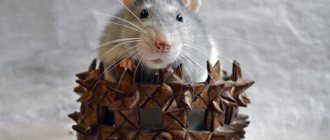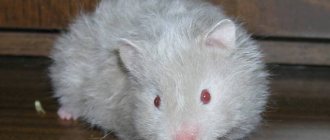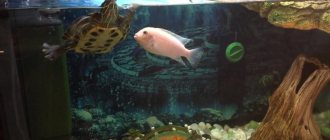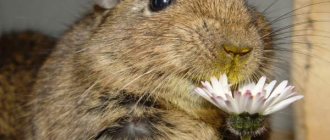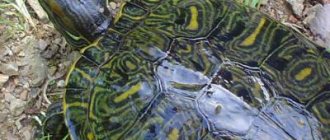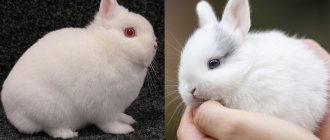Ferrets have been known as loving pets for over 2,000 years. Domesticated ferrets are called ferrets or furo. This subspecies comes from the forest ferret. All existing species and subspecies of these animals interbreed with each other, as well as with related species of small predators (for example, mink, weasel) and produce viable offspring.
In recent years, ferrets have become popular pets in our country, so many of us are interested in the question of how long ferrets live at home. The answer to this depends on a number of circumstances, the most important of which are the conditions under which the animal is kept.
Why is it dangerous for humans?
Wild ferret
In nature, a wild ferret can be found quite rarely, despite its extensive habitat. Ferrets are distributed throughout Eurasia, North America, Central and Central Asia.
Wild ferrets are bold and aggressive animals. They pose no danger to humans unless disturbed. They will not attack without reason. If you try to catch a ferret and drive it into a corner, it will defend itself, hiss and attack.
If you are close to a ferret’s home in which there are cubs, the female can become aggressive and attack, protecting her offspring.
Wild ferrets are also carriers of dangerous diseases that can be transmitted to humans. Ferrets can suffer from rabies, which is dangerous both for the carrier and for humans. The disease quickly affects organs and leads to death.
domestic ferret
Domestic ferrets pose virtually no danger to humans. The ferret, the so-called domestic species of ferret, has an easy-going disposition and is peaceful.
Some individuals may still show aggression. Such a ferret can bite or scratch painfully. Ferrets' teeth are sharp and slightly curved, so the wound is torn and painful. Scratches are not particularly dangerous. Ferret claw marks can be compared to scratches from a cat or dog. They are usually not deep and heal quickly.
Domestic ferrets need to have their nails trimmed once a week. Carefully cut off the tip of the claw, trying not to touch the blood vessels.
To get a tamed individual, it is better to purchase a ferret from breeders. Since childhood, they have already become accustomed to humans and trained. When purchasing a ferret, in a pet store, from hand or on the market, there is always a risk of getting an aggressive and untamed animal.
At home, a ferret can only be dangerous if it is scared. Then he uses his weapon - he secretes a secretion with an unpleasant odor from the paraanal glands. The ferret also hisses and arches his back when in danger. At this point it is better to walk away and leave him alone. In order not to frighten the animal, you should avoid loud sounds and noises, including those from the TV. You should not attempt to catch or handle a frightened ferret.
It is also not recommended to put your hands into the cage of an unfamiliar ferret, for example, at a party or at the zoo. Ferrets are able to remember their owner and family members. He may be afraid of a stranger and mistake him for an enemy.
If you purchase a young ferret or engage in breeding, it is worth considering that the cubs bite painfully. They usually play with each other and bite. Since ferrets have thick and durable skin, they are not as sensitive to each other's bites as they are to humans. From an early age, it is necessary to train your ferret and let him understand that biting is not allowed.
General information
The ferret is a mammal of the mustelidae genus. Vigilant and dexterous, this animal is a born hunter. As soon as it gets dark, the ferret goes hunting. The predator feeds on voles, gophers, frogs, insects, etc. It is important for him to have his own shelter, which, however, he rarely digs on his own. It settles and lives in hollows, haystacks, burrows of other animals, in buildings such as barns and cellars.
The domestic ferret (ferret) was bred from the forest at the beginning of our era in Europe. Appreciating the agility and hunting instinct of the animal, the man pursued the goal of obtaining a catcher of mice and rats. Interestingly, representatives of this species are often confused with stoats.
If you attempt to domesticate a ferret found in the wild, you will not succeed.
What rules regarding nutrition and training must be followed to ensure that the ferret's life expectancy is as long as possible are described below. Don't forget: it's not just how long a ferret lives that matters, but also the quality of its life.
How long do ferrets live at home?
Note that in the wild, domestic representatives of this species will not survive at all. Such animals are simply not adapted to exist in the steppe. How long do ferrets live at home? With proper care and a balanced diet, their life expectancy is 10 years. Although some representatives lived to be 15-18. This is how long domestic ferrets live. There are factors that can reduce the lifespan of an animal by five to six years. These include acquired or hereditary incurable diseases.
But we can say with confidence that keeping animals at home does not shorten the lifespan of animals. Now you know how long ferrets live at home. Of course, all the data given above are statistical averages. Therefore, a lot depends on conditions and nutrition.
We figured out how long a ferret lives. Now we need to highlight the main conditions for the long life of this beast. A lot here depends on nutrition. It should be as balanced as possible. You should always remember about the individual characteristics of your pet. When giving any new product, it is necessary to observe the animal’s reaction. Note that ferrets eat almost everything, but do not forget that they are predators. Therefore, the basis of the diet is meat. You can give these animals beef, offal, chicken, and horse meat. Some types of fish are also allowed, of course, without bones.
If you do not give your pet meat for a long time, then as a result his immunity will decrease, the digestive system will also be disrupted, and it is possible that his hair will fall out.
You can supplement your diet with special vitamin and mineral complexes. You should definitely consult a veterinarian about this. Of course, hygiene also affects the life expectancy of a pet. Ferrets love cleanliness and order. Their cage needs to be cleaned daily, rags and bedding changed. The home should always be warm and, of course, dry. Bowls and drinking bowls must be washed daily.
Feeding
The question of what a domestic ferret eats is extremely important. The condition of the animal’s coat and its overall health depend on this. The diet can be based on feeding natural food or using dry food. It is quite difficult to create a balanced menu of natural products, taking into account all the vitamins and other nutrients necessary for the animal. Therefore, if you are an amateur in breeding trochees, then it is better to opt for drying.
You can purchase special food for ferrets at a pet store or feed your pet premium dry food intended for cats. The nutritional needs of these animals are very similar. It is preferable that the product contains poultry meat and is intended for kittens up to one year old or pregnant cats. Additionally, you can give your ferret treats in the form of special “chews” and “crunchies” from the pet store, as well as fruits and vegetables. Do not forget that your pet always has access to fresh water in unlimited quantities. There is no need for vitamins and other food additives when feeding by drying. The food contains all the components necessary for full development.
If you have chosen natural food, then your pet’s daily menu will consist of the so-called “farshekashi”, which is meat and offal, cereals and vegetables minced through a meat grinder.
The mixture should include:
- Meat - beef, veal, chicken, turkey, lamb - can be eaten raw, it is very important not to remove cartilage, veins and skin from the meat.
- By-products – heart, kidneys, chicken giblets, liver.
- Fish – trout, flounder, herring, horse mackerel, mackerel, cod (grind with head and bones).
- Cereals – millet, rice, buckwheat, oatmeal.
- Chicken eggs must be boiled, quail eggs can be given raw.
- Low-fat cottage cheese.
- Cheese (only as a treat).
- Vegetables and fruits - no more than 2% of the total food.
- Vegetable oil.
- Fish fat.
Products prohibited for ferrets:
- Citrus.
- Nuts.
- Apples and carrots.
- Onion and garlic.
- Sweet and floury.
- Sausages and smoked products.
- Salty foods.
- Fish – haddock, hake, blue whiting, pollock, pollock.
- All dairy products, except cottage cheese, cheese and goat milk.
- Dog food.
- Economy class cat food.
- Any food from the human table.
Many ferret owners are interested not only in the question of how to feed their ferret correctly, but also how many times a day. The famous expert on these animals, the author of many books about ferrets, Kim Schilling, writes in her works that horis are not dogs or cats in order to eat food strictly on a schedule. He recommends that there is always food in the animal's bowl. As a rule, animals eat about 7 – 10 times a day, but little by little.
On average, an adult female eats up to 200 grams per day. “farshekashi”, male – up to 270 gr. The minimum portion for sexually mature individuals is 160 g. A pregnant female or breastfeeding female needs a portion of food from 200 to 350 grams.
For the harmonious development of a domestic ferret, mineral and vitamin supplements must be regularly added to natural food. This is especially true when feeding puppies, pregnant or lactating females. The exact dosage of beneficial supplements should be checked with a veterinarian.
Many owners of trochees also practice a third method of feeding - giving their pets whole carcasses of chickens and mice, cockroaches and mealworms. Thus, they create a kind of illusion of feeding, close to nutrition in wildlife.
Ferret: main characteristics
Strictly speaking, ferrets are not exactly rodents, but mammals that hunt these same rodents: mainly mice. They belong to the mustelidae family and are close relatives of the weasel and mink. They are found almost everywhere: 3 species are observed in North America and Eurasia, and 2 in Russia: dark (forest) and light (steppe). Interestingly, in South America, the ferret was made a pet a long time ago and was used instead of a cat, as well as during rabbit hunting.
In their natural environment, ferrets live alone, so it is also better to keep them separately in a cage. The steppe species hunts not only mice, but also hamsters and gophers, as well as birds, which also indicates certain rules for keeping an animal in an apartment. Lifespan in the wild rarely exceeds 3-4 years due to external factors. However, as for how long ferrets live at home, the numbers here are also small: 5-7 years. Rare individuals live up to 8-10 years.
At the same time, the apartment usually contains a dark (forest) ferret, as well as a furo - a very light ferret, similar to an ermine. Little is known about the origin of the latter: it is called a hybrid of forest and steppe, their domesticated form, and some are inclined to think that it is an absolutely independent breed. True, in terms of the chromosome set, the furo is still close to the forest ferret, as well as in terms of morphological features. The lifespan of furo is, accordingly, the same - 5-7 years in an apartment.
Liberty
Typically, ferrets live in a cage that is arranged according to their preferences, but you can also give your pet the opportunity to move freely around the apartment. To do this, you need to remove all small objects, and also make sure that vital wires are inaccessible to the rodent. It is also important to remove objects from the animal’s habitat that could injure him: knives, ski poles, guitar strings, poorly placed heavy folders, objects that break into fragments - the ferret is a very active animal, anything that can be chewed and dropped will certainly be chewed and dropped, especially if the ferret ended up in your house as a puppy.
How many years do ferrets live at home?
Owners protect their pets from various unfavorable factors, and with good care, pets have a much longer life expectancy.
Pets can reach this age only with proper care, proper feeding, and systematic veterinary care. There have been recorded cases of ferrets living up to 18 years.
Domestic ferrets need to be neutered. The procedure must be carried out after 6–8 months from the date of birth. A spayed male will not go into rutting season, and females will not go into estrus. The rut in males approximately begins at 5–8 months and lasts about six months. These deadlines may change.
During this period, males have a distinctive feature: they develop an unpleasant odor. Ferrets' behavior also changes. They become aggressive and restless, and begin to mark their territory. The structure of the coat changes: it looks dirty and sticky, and may thin out. A number of diseases of internal organs appear that can lead to the death of the pet.
A distinctive feature of females is that estrus does not stop when deprived of mating. It can last for several months, and this leads to a deterioration of immunity. If left untreated, it will lead to the death of the pet. After sterilization, the behavior of animals changes: they become calm and non-aggressive. It has been proven that in animals that have not had offspring, sterilization leads to an increase in life expectancy.
Being in the same home with members of the household, the ferret quickly becomes a favorite pet, giving with its presence a good mood and a lot of positive emotions
Therefore, it is important for owners to extend the life of animals, taking into account their lifestyle, character and living conditions
Little ferret
What affects life expectancy Why is this necessary What happens if you don’t listen to the recommendations Spacious housing Spacious housing is important for an animal. The cage should have everything necessary for living: a feeder, a drinking bowl, a tray, and “simulators”
Small housing has a negative impact on the pet, causing stress. Balanced diet The ferret is a predator. It feeds on chicken, turkey, horse, and fish fillets. Boiled carrots, zucchini, cabbage, chickpeas are useful. Millet, buckwheat, barley. The treat is a freshly caught mouse. Diseases of the gastrointestinal tract. Pure water in large quantities Drink 20 times during the day. A large volume of fluid prevents the body from overheating “thanks to” high mobility. Dehydration of a pet leads to death. Vitamins Your pet needs vitamin complexes; you should consult a veterinarian. Baldness of parts of the body, poor health. Physical activity For the ferret, all kinds of “simulators”, hammocks, and climbing equipment should be freely available. The young animal is hyperactive and needs to maintain “physical shape.” A sedentary lifestyle leads to poor health for your pet. Freedom of movement For a comfortable life, the animal needs to move throughout the apartment and find secluded corners. Stress, which provokes refusal to eat, baldness of the tail. Ensure safe movement around your home: swallowed small things cause death for the animal. Cage Hygiene The ferret is a clean animal. The cages must be cleaned daily: change the bedding, wash the drinking bowl and feeder. The pet's home should be warm and dry. Poor health of the pet. Psychological comfort They gladly accept care and affection from their owners. The animal should not be shouted at or left with unfamiliar pets. Behavior different from usual: often hides, does not go out to household members. Vaccinations For a full, long life, regular vaccinations are necessary, which your veterinarian will tell you in more detail. Diseases that will lead to death.
Om-Nom-nom
Diseases
Keeping a ferret is often associated with various diseases. The immunity of an animal living at home is susceptible to viruses and infections. The animal is not able to talk about its condition, so the owner must be attentive and notice any deviations in the baby’s behavior for timely help.
Diseases that ferrets are susceptible to are:
- Diarrhea is the result of poor nutrition;
- Worms. Infection occurs through contact with the environment. For treatment, anthelmintics are used;
- The mite appears under unsanitary cell conditions;
- Rabies and plague are serious diseases; timely vaccinations are mandatory;
- Infectious diseases, etc.
Breeding
Domestic ferrets, depending on whether they are female or male, are ready to breed at the age of 9-11 and 6-8 months. If you decide to breed them, you need to know that:
- their puppies are born premature;
- females have false pregnancies;
- In order for the babies to be born strong, the female must be fed properly.
Breeding ferrets are suitable for breeding. Individuals must be vaccinated. The female moves into a separate cage before giving birth. She can have up to 10 puppies. The female feeds the babies for up to 4 months. If further breeding is not planned, then the individuals are sterilized.
Factors influencing life expectancy:
- The very first and most important factor, which, unfortunately, is not under your control, is heredity. If your ferret's parents died of natural causes at the age of 5-6 years, then there is a huge chance that your animal's genetic code has the same life span. Club breeders aim to increase the life expectancy of their offspring by selecting genetically healthy animals for mating, so, as a rule, their ferrets live somewhat longer.
- As I said above, a lot depends on the owner himself, on his care for the animal. Improper diet and care, indifference to the health of the animal, constant cage housing without physical activity, all this negatively affects the life expectancy of the ferret. You cannot feed your ferret soups, bread and other “food from the table”; he is a predator, so his diet must contain meat ingredients in predominant quantities. Read the corresponding article about nutrition and care. In addition, the ferret needs active muscle exercise to prevent the development of a disease such as muscle anemia. Therefore, walk him outside every day and let him run around the apartment for several hours.
- I often meet breeders who do not close the kitchen, where there are many open food sources, and some even feed their ferret with prohibited foods. Thus, they get various gastrointestinal diseases, which significantly affect not only their future quality of life, but also their duration. Remember that even a small piece of chocolate can lead to the death of a student, no matter how much he asks you to treat him to it. They will be happy to taste everything, but this could turn out to be a disaster for him, at best poisoning. It is better to completely block the animal’s access to the kitchen, and, as reward or pampering, give only permitted treats, and then in small quantities. Read the relevant article on what you can treat your ferret to.
- In 5-6 year old choreas, malignant formations – cancer – are very common. Unfortunately, scientists cannot yet indicate the specific reason for its formation, but there is an assumption, confirmed by test results, that ferrets fed dry food, which has a high presence of carbohydrates, are more susceptible to cancer, which is the causative factor. Animals that eat natural food are less susceptible to this disease. Draw conclusions.
- Some breeders are either unaware or deliberately spare money on annual ferret vaccinations against rabies and canine distemper. This cannot be done, unvaccinated animals get plague in 60% of cases, and rabies in 10% of cases, even if you avoid contact with other animals, there are plenty of sources of infection. Even your outdoor shoes can become a source of infection, or a mouse. Do not neglect vaccination, it is also in your interests.
Perhaps I did not give such a comprehensive answer about how long ferrets live in captivity, maybe I missed something important. But by observing everything that I described above, you will avoid many unpleasant situations that in one way or another can affect the ferret’s lifespan or lead to its death
And death is the final stage of life, the end of its term. Take proper care of your pet, closely monitor all its actions, do not expose it to physical harm, then your ferret will live a long and happy life.
How long does a ferret live? To answer this question, you need to study the topic in more depth.
First I would like to say that there are domestic ferrets and wild ones. You must understand that these animals are completely different, they have a different chromosome set. They were even given two separate Latin names: “policat” and “ferret”.
Biologists claim that before the ferret became domestic, gradual changes occurred in its code (chromosomal) for quite a long time, as a result of which this animal became a friend of man and was able to get along at home. I would like to note that a wild ferret that is caught in its natural habitat cannot be tamed. It's like bringing a tiger into your house and calling it a house cat.
Historical reference
The first mention of the ferret is found in the works of the Greek satirist Aristophanes. He lived from 448 to 385. BC e. and in his plays he described a certain marten-like animal that was a pet. Another Greek historian, Strabo, described the fret's hunt for rabbits that flooded the Balearic Islands. There is also evidence according to which Genghis Khan himself in the 13th century, while in Afghanistan, used ferrets for hunting.
In Russia, the history of keeping ferrets begins in 1971, when a pair of furos was given to Soviet zoologists Dmitry and Yulia Ternovsky from the Prague Zoo. The ferret began to spread as pets only in the mid-90s. In 2002, the first clubs for domestic ferret lovers were organized.
How to care for an animal after castration
After surgery, the ferret is wrapped in a blanket or blanket to provide him with a comfortable environment and help him adapt faster.
Ferrets recover from anesthesia very quickly, but for several hours they cannot control their actions: pets can rise to their paws and immediately fall to the side, shaking their heads. Within a day, the ferret's condition returns to normal.
Sutures are treated with chlorhexidine or another agent prescribed by a veterinarian.
You should not expect a drastic change in behavior from your ferret. The animals become calmer a couple of months after the operation, and over time their temperament gradually evens out.
Feeding your ferret after sterilization
After sterilization, the metabolism changes somewhat, and some processes in the animal’s body slow down.
To maintain a normal balance of proteins, fats and carbohydrates, special food is needed not only for sterilized ferrets, but for all ferrets. Ready-made professional food should be purchased only from premium and super premium manufacturers with an impeccable reputation.
Bosh Totally Ferret ferret food is a complete, super premium ferret food. This food contains easily digestible proteins, vitamins and minerals that make your pet's coat smooth, shiny and silky. This food is even used in the diet of ferrets that are preparing to participate in an exhibition.
Life expectancy of ferrets
Here it is worth drawing a clear line: whether we are talking about a domestic ferret or one that lives in the wild. The latter faces dangers, diseases, malnutrition and larger predators. The average duration of their existence is 2 years, and the most resourceful and cautious ones sometimes live up to four.
And what, in four years, this sweet and beloved baby, who appeared in your house and is exploring the surrounding space with such interest, will simply die! No, nothing like that, if you take good care of it and carefully monitor that your pet has enough of everything.
Eighty percent of the exact figure will depend on what the owner feeds his pet, how he cares for him and whether the ferret has any hereditary diseases. With a good diet and proper maintenance, the average lifespan of an animal at home will be 8 years, but you can try to make sure that the animal lives with you up to 15 years; such cases are not uncommon.
REFERENCE: a ferret or, using another name, a ferret, is a mammal that belongs to the order of predators, the mustelidae family. Even 800 years ago, ferrets were domesticated and served humans in the same way as hunting breeds of dogs still serve, but rabbits became the ferret's prey. Only much later did people appreciate the ferret’s quick wit and intelligence, let him into their homes, and his place became directly next to a person, which ferrets do not object to at all to this day.
In wild nature
The wild forest ferret is the most nimble, most attentive predatory of the representatives of its order. They live in the European part and in the North of Russia
It is very important for a ferret to have a body of water nearby, even if it is a simple stream. When the winter is snowy and cold, they move closer to people's homes.
The animals feed on small rodents, such as voles, hamsters, moles, and water rats. They do not disdain birds; they eat fish and vegetables with less pleasure. Many people hunt for the forest ferret - owls, foxes, wolves, and even snakes. It is not surprising that its life in the wild is so short.
ATTENTION! The ferret is a fast animal, but it cannot compare with the ermine and weasel. An adult can easily catch up and grab the animal, but you shouldn’t do this
In a moment of danger, the animal activates a defensive reaction - it sprays a strong-smelling liquid from the secretion of the anal glands towards the enemy, and besides, in the wild, ferrets are angry and quite aggressive, catching him can result in severe bites and scratches.
At home
At home, the ferret is playful, affectionate, can learn commands if she wants, of course, she is accustomed to a tray and harness, and quite easily finds a common language with cats, dogs and small inhabitants of the house. An additional bonus for allergy sufferers is that ferret fur does not cause allergies. Well, for those who spend a lot of time at home, breeding ferrets can be a good income, especially since tinkering with baby ferrets is an incomparable pleasure.
How long will a sterilized animal live?
If you are not going to engage in breeding, then it is better to sterilize the ferret - this will significantly prolong its life and improve the health of your pet. At 6-8 months, the so-called rutting period begins for little ones - the hormonal background changes, the character changes, nature takes its toll and demands procreation.
If at this time you do not provide the opportunity for reproduction or do not sterilize the animal, then it will become aggressive, nervous, restless, there will be a failure in the hormonal system, first baldness will occur, then problems with internal organs will arise and your pet will quite possibly die. If the ferret is sterilized, then all this can be avoided and the animal may well live up to 15 years, while the average lifespan of a ferret is 8 years.
Relationships with other pets
If you have other pets in the house, it is better not to show them to each other right away. A decorative ferret must first become familiar with its habitat and get used to the conditions. The best way to communicate is with the same animal. They will quickly become friends and spend a lot of time together.
With dogs
The interaction between ferrets and dogs depends on the breed of the latter. Large breeds of dogs are more popular with small animals; they are associated with tender feelings and strong friendship.
Small breeds of dogs cause irritation in them due to the similarity in character. Ferrets hurt small dogs. Hunting breeds, on the contrary, can offend a small neighbor if they see him as prey.
The most successful condition for the emergence of friendly relations between a dog and a ferret is if you brought a small animal to an adult dog; or both childhood pets.
With cats
Ferrets and cats can develop a wonderful relationship, or they may not pay attention to each other. But there will be no enmity between them if the owner loves them equally.
Cats are used to being loved, so they should not see the owner's warmer attitude towards the ferret.
With birds, rodents, reptiles
You should always remember that a ferret is a predator. Birds, rodents, fish, lizards are prey for him. Therefore, they should be kept in a remote place.
Life at home
At home, the American ferret can live on average from 9 to 15 years. However, there are several cases known in which animals died at the age of six.
Various diseases, improper living conditions, insufficient nutrition, and lack of vaccination can affect the life cycle of an animal. These factors shorten the pet's life.
Experienced specialists identify a number of reasons why an animal may die. Let's take a closer look at the main reasons for the shortening of a ferret's life.
Genetic predisposition and heredity
If the pet's parents died at an early age, then the black-footed ferret may also die after 6 years. Therefore, most professional breeders approach animal breeding with great responsibility. To do this, they select healthy individuals whose parents lived to be 15 years old. As a rule, most representatives live in a new litter for more than 10 years.
Care
The lifespan of a ferret depends on the owner
Particular attention must be paid to caring for your pet. The most important thing is diet, vaccination and regular care.
The animal's menu should not include products from the common table. Its carnivorous nature requires a high-protein menu. To do this, the owner needs to stock up on low-calorie varieties of meat and fish. For feeding, choose turkey, chicken or rabbit.
In order for muscle tone to always be at its best, the animal needs regular physical activity. To do this, it is enough to purchase special equipment at a veterinary store. Some breeders prefer to walk their furry pets using special leashes. At one time the animal is able to cover more than 3 km of path.
Gastrointestinal disorder
Most breeders prefer to give their black-footed ferret complete freedom. To do this, they release the predator outside its cage. The animal moves independently throughout the living space and is often subjected to gluttony from the common table.
The predator actively eats fatty and salty foods. Subsequently, he was tormented by problems with the gastrointestinal tract. Everyone at the veterinarian's office has probably encountered a sick ferret who has been diagnosed with diarrhea or prolonged constipation. This phenomenon can be prevented by regularly monitoring the pet’s movement around the apartment.
Oncology
Most American ferrets are diagnosed with actively growing cancer cells by the age of 6 years. Tumors are located in the head, abdominal or pelvic region of animals.
Scientists have not yet figured out the main cause of these diseases. However, there is an opinion that unbalanced nutritional compositions can provoke cancer. They contain the maximum amount of protein, which negatively affects the functioning of the gastrointestinal tract. The animal does not have time to spend the energy received, as a result of which the remaining food rots in the intestines.
Surely every breeder has noticed flatulence in an animal after the next meal. Therefore, most veterinarians recommend feeding animals food that contains a large amount of fiber. This substance reduces the animal’s appetite and stimulates the gastrointestinal tract.
Wrong vaccine
Experienced breeders regularly vaccinate their ferrets against rabies. In fact, the emphasis should be on the plague vaccine. An animal raised in artificial conditions is considered susceptible to microorganisms. It is enough not to wash outdoor shoes, but to leave them in the same room with an animal for it to pick up a virus. Therefore, it is necessary to carry out regular wet cleaning in the house.
Proper care
We are responsible for those we have tamed. An animal is not a toy, it requires, like a child, that effort be put into its maintenance and upbringing, and therefore its care must be appropriate. You can't feed your ferret whatever you have to. The basis of the diet should be raw rabbit, turkey, offal, chicken, trout, buckwheat, low-fat cottage cheese, quail eggs, vegetables, and special vitamin complexes.
Proper ferret diet
The lack of necessary minerals in a ferret’s diet leads to the development of gastrointestinal diseases, vitamin deficiency, decreased immunity, and hair loss. The water in the drinking bowl should always be clean. It is necessary to ensure that the rodent does not get any prohibited product, because even a small piece of harmful food can cause food poisoning in the animal. It was noted that ferrets fed dry food were more likely to develop cancer. It is important to feed your pet natural food.
You cannot feed an animal in a closed cage for days: this negatively affects its physical and moral health. You need to regularly arrange walks and games in the fresh air. We must not forget about training and muscle loads. The ferret is a friendly animal, inquisitive and easy to contact, so it needs attention and dedication from humans.
It is necessary to observe the rules of animal hygiene, regularly carry out wet cleaning in the room where the rodent lives, ventilate, and change bedding.
What does a ferret look like: differences between male and female
First of all, ferrets have very clear differences between females and males in size. Males are much larger than females. However, let's take a closer look at their differences.
Female
Girls are much smaller than ferret boys. They grow 37-39 cm in length. Growth in females stops by 6 months, while males grow up to 10 months.
Girls are slimmer and more graceful in appearance. They have a graceful and more pointed muzzle. They are active, smart, quickly learn tricks and sometimes show great intelligence. However, they are also more aggressive. Females are less attached to people and can organize their leisure time independently.
Advantages of keeping a species
- The small size of the animal allows you to keep it even in a small or communal apartment.
- The fry is a very clean animal and is easy to litter train.
- The animal easily gets along with a group of other pets, both ferrets and dogs or cats.
- The animal is easy to transport due to its compactness.
- Despite its nocturnal lifestyle, it adapts to its owner’s daily routine: while you are at work, it will sleep (up to 14 hours a day), and when you come home, it will play with you.
- Ferret fur is less allergenic than cat fur. Unlike cats, the animal is more attached to its owner.
- A very funny and playful pet, never sits still, loves games.
- Unlike dogs, it does not require daily walks and physical activity.
- He gets used to the harness very quickly: literally the second time.
How long does a ferret live at home and what causes this?
On average, a pet in a cage or enclosure can live up to 9 years. This is a long time for a rodent. This life expectancy can be ensured by 5 main factors.
- The animal eats ready-made food, which greatly reduces the load on the digestive system, and therefore most of the energy spent on digesting food is now spent on the functioning of the body’s protective functions. The ferret grows stronger and stronger.
- Living conditions also affect life expectancy. In a house or apartment there are significantly fewer viruses and bacteria that can provoke various diseases. The ferret gets sick less often, but if the animal gets sick, it will immediately be treated with ointments, tablets and injections, which can get the pet back on its feet within a week. In the wild, the animal fights illnesses on its own, which takes a lot of strength and energy.
- Vitamin supplements. In the forest or steppe, the ferret produces food on its own and receives all the necessary micro and macroelements, but they are often not enough (especially in winter) for the normal functioning of the body, and the animal weakens. The owner can add vitamin supplements to the food at any time, and the animal will not feel a lack of certain elements.
- Nature forces ferrets to constantly mate and reproduce, which takes a lot of energy, especially for females. A sterilized domestic animal has no need or inclination to reproduce, which allows it not to waste nutrients on offspring.
- A wild ferret must constantly expend energy digging burrows, searching for food, and avoiding enemies. Such actions greatly wear out the muscles and heart of the animal, which is why the life expectancy of the ferret in nature is greatly underestimated. In an apartment or in a private house, there is no need for these actions, which is why the pet is able to live much longer.
As has already become clear, ferrets live much longer at home, but why do these numbers differ among different ferret owners? It's all because of the conditions of detention.
Averages
On average, ferrets live with humans for about 8-9 years, with a maximum of 15. For comparison: a wild one barely crosses the 5-year mark. This is due to the natural conditions in which he lives, enemies - larger predators, lack of food, parasites. Wild ferrets cannot last as many years as domestic ferrets live.
The owner must surround the ferret with care
No living creature is immune from sudden death. It is up to the owner to provide everything necessary so that his pet stays with him as long as possible. How many years ferrets live in captivity largely depends on the conditions created for them.
OUTDOOR GAMES
Walking a ferret on the street or keeping it only in an apartment is a personal matter for each breeder. But walks in the fresh air can significantly strengthen your pet’s immunity.
You can take a ferret outside only if it is vaccinated against most dangerous diseases, and if the walk is in a place safe from wild animals.
Due to the fact that ferrets are inquisitive and impressionable animals, playing with fallen leaves, in the sand or in snowdrifts will bring your pet a lot of pleasant experiences.
Video: useful information about your pet
Ferrets are delighted with digging holes and tunnels in the snow, but the animal must be accustomed to the cold gradually, in doses, starting with 10-15 minutes of being outside and excluding sudden temperature changes.
If you provide your ferret with tasty, varied and healthy food, quality living conditions and give him at least a little attention, then your pet will be strong and healthy, and will be able to remain your devoted and faithful friend for many years.
Choice of animal
As pets, ferrets are very unusual. Therefore, you need to approach the choice of a pet responsibly, paying attention to any little details:
- You should buy it from a nursery to be sure of its good heredity and that you were not sold a wild specimen. Take contact information from the breeder so you can contact him after purchasing the pet.
- The age at the time of purchase must be no younger than 1.5 and no older than 4.5 months. In determining the age, you will have to rely on the honesty of the breeder.
- Health is the main selection criterion. The eyes, nose, and fur should be clean, movements should be smooth, and the ferret itself should not be aggressive. By the way, if an animal gets scared and behaves viciously, this may be a sign that it is wild and not domestic.

